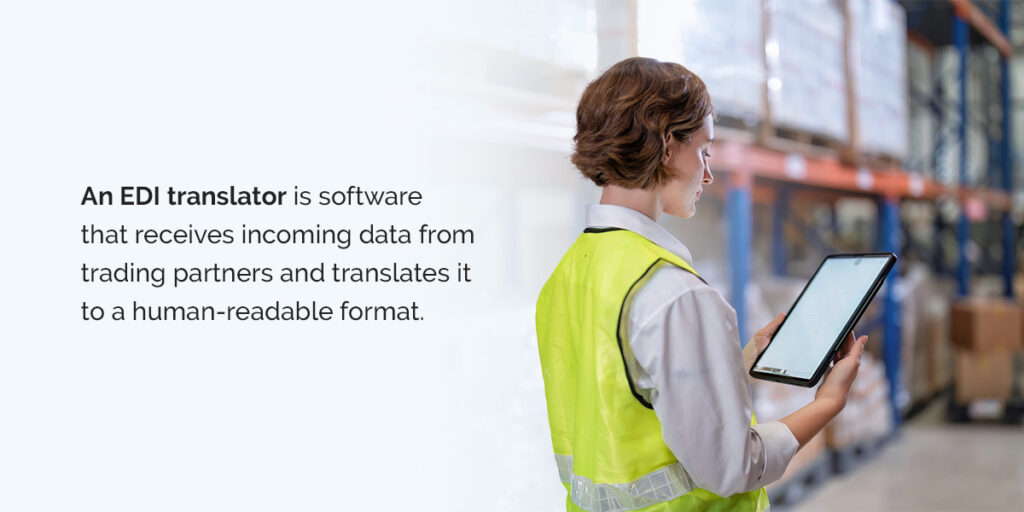Cloud EDI vs. On-Premises EDI

October 18, 2023
Efficiently communicating order data is critical for continued business growth. For years, businesses used electronic data interchange (EDI) to speed up order processing, increase efficiency, and comply with retailer requirements. The ability to automate and streamline document exchange with EDI makes it easier, more efficient, and more cost-effective for partners to do business with you, helping you grow your business.
Businesses have traditionally used on-premises EDI to manage these transactions. Yet many trading partners are turning to cloud-based EDI for a solution that provides greater agility and reduces manual processes. How do you know which EDI system is best for your company? Understanding the pros and cons of each option equips you to make the best decision for your company’s needs.
Cloud EDI
Cloud-based EDI, also called web-based EDI, is an EDI solution that works through the cloud rather than in-house data servers. To run cloud-based EDI, companies need:
- An EDI solutions provider: Companies that want to use EDI in the cloud must go through an EDI solutions provider. An EDI solutions vendor provides the servers and network needed to operate web-based EDI and IT support to ensure messages flow smoothly.
- A web-based EDI translator: Companies use a web-based EDI translator to format EDI transactions to meet business needs.
- A network: Web-based EDI solutions require a secure network dedicated to sending and receiving EDI transactions. Some types of networks for EDI transactions are Value Added Networks (VANs) and Single Channel Networks. However, VANs require manual document processing, and Single Channel Networks make it difficult to expand across different sales channels. Many companies choose a multi-enterprise commerce network, which provides one global network that connects thousands of trading partners.
Pros of Cloud EDI
Many companies view cloud-based EDI as a better way to send and receive EDI transactions. Consider some of the pros of using cloud EDI to communicate with your trading partners:
- Reduced costs: Traditional EDI solutions require businesses to buy and install large data servers. Cloud-based EDI doesn’t require any of these upfront costs, instead charging a single monthly price for the use of the system.
- No need to maintain the system: With web-based EDI, the EDI solutions provider handles all aspects of hardware maintenance, including the cost of replacing server components. The solutions provider also maintains a team of IT professionals to ensure EDI transactions run smoothly, so their customers have no responsibility to maintain the system. These features make cloud-based EDI an excellent solution for businesses without in-house EDI expertise or with lean teams.
- Ease of scaling: Cloud-based scales seamlessly, providing the adaptability your company needs to work with any trading partner. When you need to scale your cloud EDI use up or down, your EDI solutions provider works with you to adjust your package. The provider provides additional server space if needed, and your team doesn’t have to install new software or hardware.
- Eliminated manual data entry: Entering EDI transaction data into your company’s enterprise resource planning (ERP) or accounting system is inefficient. With web-based EDI, you can integrate EDI data with your business system automatically. Data syncs instantly across all systems and applications. Employees can focus on higher-priority tasks, boosting efficiency.
Cons of Cloud EDI
Cloud EDI also has a couple of potential disadvantages. Consider the possible cons of implementing EDI in the cloud:
- Less control: When a company outsources its EDI solution, it gives up some control. Companies can’t update the software or change an aspect of their operation without consulting with the EDI solutions provider.
- Switching providers: If you ever decide your company would benefit from a different EDI solution, you must research different providers and select a new one. If you had an in-house EDI system, you could make the changes you wanted. However, that process could also be time-consuming.
On-Premises EDI

On-premises EDI leverages on-site servers and EDI software from a company’s computing infrastructure. To operate using on-premises EDI, companies need the following resources:
- EDI Translator: An EDI translator is software that receives incoming data from trading partners and translates it to a human-readable format.
- Servers: On-premises EDI solutions run on a company’s in-house data servers. It’s also critical to invest in data backups and redundancy.
- Support staff: Because each company runs and manages its own on-premises EDI solution, they need internal support and IT staff to oversee the solution and mitigate any issues that arise.
Pros of On-Premises EDI
Although on-premises EDI is no longer the only EDI solution available, the method is still popular with some companies. Here are a few reasons why it might make sense to use on-premises EDI:
- Complete control: Companies that prefer full control over their data security, access, and integrity may choose on-premises EDI since the solution runs on in-house servers and software.
- Ideal for smaller businesses: On-premises EDI solutions may be a better solution for those companies with fewer incoming orders. With less orders, there is less strain on in-house processes which could lessen the investments needed on more data servers.
Cons of On-Premises EDI
On-premises EDI solutions also come with unique disadvantages. Companies should weigh the cons when considering whether to use this solution:
- Cost: Purchasing, installing, and maintaining the servers and software necessary for an on-premises EDI solution can become prohibitively expensive. Companies using on-premises EDI solutions must hire the necessary IT staff, invest in more servers when needed, and shoulder the burden of maintenance.
- Lack of automation: On-premises EDI typically requires manual data input into your company’s ERP or accounting system. Manual data entry is inefficient and prone to errors.
- Difficulty scaling: Businesses with a low number of trading partners manage EDI transactions on their existing in-house servers. However, as your company grows and handles a greater volume of orders from trading partners with their own EDI requirements, it becomes more challenging to maintain on-premises EDI.
- Complexity: On-premises EDI requires skilled in-house teams to deploy and maintain the solution. Juggling differing EDI requirements from trading partners and solving transaction errors can be difficult for even a larger company to manage.
Why a Hybrid Model is Best
Today’s trading partners need modern EDI solutions to maintain a competitive edge and meet modern demands. When you want the benefits of a web-based EDI system and the control that an on-premises EDI solution provides, a hybrid EDI model may work best.
A hybrid approach lets you work with an EDI solutions provider to create a system that meets your business needs. For example, integrating EDI with your ERP system allows you to continue using your company’s mission-critical ERPs, including leading systems like Acumatica, Oracle NetSuite, Intuit, Sage Intacct and X3, and SAP.
Working with TrueCommerce to integrate your EDI, and the ERP system of your choice, allows you to build a solution that integrates seamlessly with your tech stack and provides all the benefits of cloud EDI.
Stay Connected to Trading Partners With Cloud EDI
Streamlining supply chain processes is more critical than ever in today’s market. A robust EDI solution that keeps you connected to your trading partners, eliminates inefficiencies and errors, and integrates with your other business systems provides the agility and flexibility you need to stay ahead of the competition.
If you’re looking for a cloud EDI solution that provides the benefits of easy scaling, simpler maintenance, and integration with your ERP system, partner with TrueCommerce. TrueCommerce cloud-based EDI solutions enable seamless ERP integration that connects you with a global network of trading partners.
To see how TrueCommerce cloud EDI can transform the way you do business, request an EDI demo today.

Share this post:
Categories
Stay ahead of the competition
Get expert supply chain insights delivered directly to your inbox weekly.